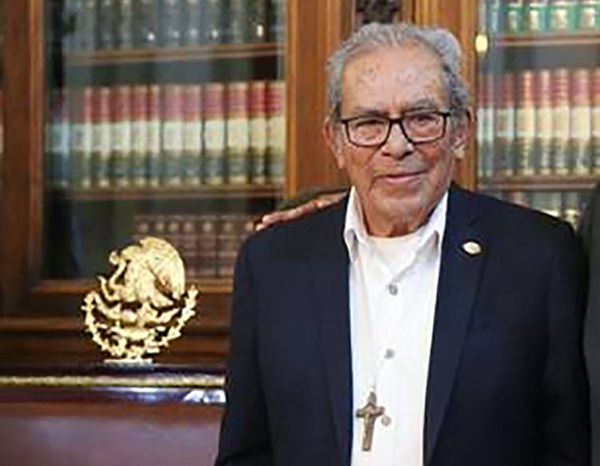
By David Agren
MEXICO CITY (CNS) — Retired Bishop Arturo Lona Reyes of Tehuantepec — known as “bishop of the poor” and famed for promoting an indigenous church — died Oct. 31. He was one day shy of his 95th birthday and had tested positive for COVID-19 earlier in October.
“With the passing of Don Arturo Lona Reyes, it closes a chapter of prophetic pastors who were committed to justice and the transformation of oppressive and exclusionary structures,” tweeted Father Alejandro Solalinde, director of a migrant shelter in the bishop’s former diocese.
Known for his candor, salty language and informal appearance — he often wore blue jeans, a T-shirt and a large wooden cross — Bishop Lona served the Isthmus of Tehuantepec region in southern Oaxaca state for 29 years.
He put a special emphasis on ministering to indigenous communities, especially through indigenous education and the training of indigenous priests, and was among the first bishops in Latin America to focus on environmental matters. Bishop Lona also promoted cooperatives, including Mexico’s first for organic coffee, according to the newspaper La Jornada.
“He was the last survivor of a group of young bishops appointed by either St. John XXIII or Pope Paul VI to some of the poorest dioceses in Mexico in the 1960s,” said Rodolfo Soriano Núñez, a sociologist who studies the Mexican church.
Soriano-Núñez said Bishop Lona eventually came into conflict with the church leaders — especially with Archbishop Girolamo Prigione, then-apostolic nuncio in Mexico — as the bishops’ conference became more conservative.
Bishop Lona was born Nov. 1, 1925, in the Catholic heartland of Aguascalientes during the Cristero conflict. He was ordained in 1952 and served in an area of eastern Mexico known as the Huasteca. There, he worked with indigenous peoples and learned the Náhuatl language.
Pope Paul VI elevated him to bishop in 1971.
Prepared by his experience in the Huasteca and inspired by the 1968 Medellin conference of the Latin American bishops’ council, Bishop Lona promoted an indigenous church and showed a special appreciation for indigenous spirituality.
“He fundamentally (attempted) to promote the formation of an indigenous clergy,” said Massimo De Giuseppe, historian at IULM University in Milan, who has researched the Catholic Church in southern Mexico. “He also conceived the idea of a multiculturalism,” which would also exist at “the theological level” and consider “indigenous elements that could enter the Christian theological discourse.”
He also promoted a preferential option for the poor. De Giuseppe said Bishop Lona’s vision was more indigenist, however, than rooted in liberation theology.
Bishop Lona helped indigenous peoples to defend their lands against megaprojects and promoted local people’s education. He sent many indigenous men to study in the Seminary of the Southeast in neighboring Puebla state.
Mexican media said it was believed he survived 11 assassination attempts and received death threats as recently as 2015.
Bishop Lona retired in 2000 upon turning 75 and remained active in human rights and mediating conflicts.
President Andrés Manuel López Obrador tweeted condolences after Bishop Lona’s death. He posted a picture from a visit at the National Palace with Bishop Lona in 2019, when he called the churchman, “an authentic Christian.”

Respectful farewell to Bishop Arturo Lona Reyes. Eternal rest grant unto him O Lord and let your perpetual light shine upon the departed soul.